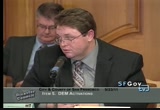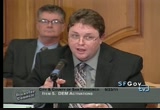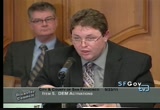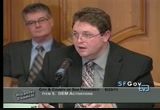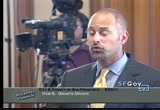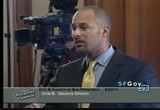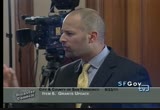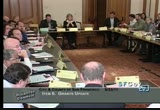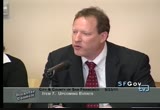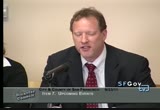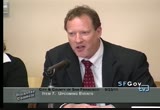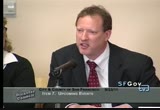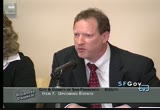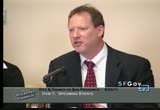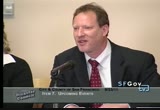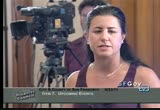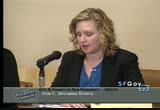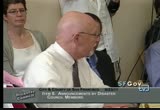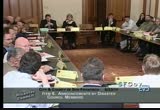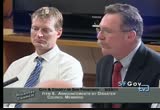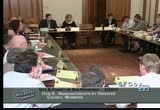tv [untitled] October 16, 2011 2:30am-3:00am PDT
2:30 am
transportation agencies and airport districts -- those types of entities that while not strictly public safety, served a fairly strong public safety function. we believe those entities could use it on a daily basis as well. obviously, in an emergency -- in an earthquake or a disaster -- everybody becomes an emergency services worker. when something big hits, obviously, i think any city employee would be eligible to use the system. and we are actually working to expand the definition even more to allow public works -- there are a variety of functions that the city performs that i would consider public safety functions. we are just trying to expand the definition as broadly as possible. on the question of devices --
2:31 am
absolutely. both the arra and the fcc are setting specific standards and requirements for these networks. we are negotiating to make sure we have clear language in our agreement with motorola. motorola has to ensure that any device that is certified is compliant by the fcc or the national standards agency in washington will operate to it's full functionality on the network. we believe that is a key component, to develop a key market for devices and hopefully drive down the price of those devices. do you have my contact information? i love to talk about this. if you have any questions that you would like to follow up, please do so anytime. then he gets very excited about this.
2:32 am
thank you. -- >> he gets very excited about this. thank you. we are changing the way we have done disaster councils in the past when we go over reports, and we will provide executive summaries for you and begin looking at trends and the things we're learning. we thought that would be more helpful at that level for the council. i will turn it over to rob, who will give you that kind of overview, our deputy director. >> as she indicated, you have some executive summaries in the packet. the one you have our are -- are bay to breaker, fallen hero and pride. what we're starting to look at -- a lot of times we go over very similar things from event to event. we're looking at trends,
2:33 am
evolution, what we're learning. drawing from that, there is a list of all the points that you can read, and i am to have her -- i am happy to answer any questions. i am always available to you. in the last six or seven months, we have implemented webeoc. this was a long time in coming. those of you who have been here for a while know we had a platform to share information that was difficult to use. it was a very clunky program, very difficult, and because we did not use it on a regular basis, that made it even worse. we went back to a paper-based system to look at how we do business as a city and how we want to operate in an emergency. we went to the vendors and said, "ok, here is how we work. give us a platform that works on the way we do things instead of a platform that causes us to have to change how we do
2:34 am
things." long story, but in the end, we picked webeoc. it came out pretty strong, pretty easy to use. it is pretty intuitive. learning curves have to be accounted for, and each time we use it, we learn more and more. that goes to the more we use it, the better we get at it, and the more valuable it becomes, the more we can refine it appeared we have seen a trend where people are getting better at using it and we are identifying better how to use it. utilization to coordinate events i think continues to be a good use of everybody's time. sometimes it seems a little slow. sometimes it seems like, "why are we here?" i would like to remind people that things do happen. while the reno air show is an anomaly, things do happen at these events. a grandstand collapse in
2:35 am
indianapolis was something nobody ever thought of happening. whenever you have large crowds, things can happen. having a lot of people in the room to solve a problem right then is how to solve it. we look at how to do special event planning from a public safety perspective and making some changes to that. we are starting to look at a more holistic approach earlier out, getting all the disciplines together and refining how we will interact and communicate at any event, defining the parameters of the event, and looking at how we handle the issues that happen at events versus the larger 911 system. the ultimate goal is that, particularly on the medical side, is that we do not impact the 911 system with a special event. if something happens like a grandstand collapse, all bets are off. but for normal things you should expect in a crowd of people, we should have those things covered and we should not have to reach into the 911 system. that creates a drain on the
2:36 am
system and impacts everyone else in the system. that is our ultimate goal. we are getting closer to that as we continue to do this pre-event planning and look at our standards for events to have things in place ahead of time. one other thing i would say we really learned -- there is a comment in here about how we moved social media function into a more active part of the eoc. the bigger lesson is recognizing that we need to continue to focus on how we communicate with all of you, with our constituency, and with the public in a timely, relevant basis. social media is one of those tools. that was a lesson that came out of the after action report. it speaks to a much bigger issue, which is always getting better about how we communicate across the board, both horizontal lee and vertically -- horizontal the -- horizontally
2:37 am
and vertically. with that, if there are any questions you would like addressed, i will be happy to do so. >> questions? ok, thank you very much, rob. our next presentation this from our emergency services manager at the department of emergency services. >> i am going to tell you how grants have been going. like the federal government, we have been suffering from the challenges of reduced budget. the two main grants we have coming -- there used to be 62 identified across the nation, which was reduced to 31. state homeland security, that was reduced by 32%. back at the federal level are starting to make their way towards us.
2:38 am
i wanted to share with you where we are right now. with the 2008 grants, those are ones we are just closing now. 2009, we're starting to spend a lot more of those funds, as well as 2010. in both cases, the grant cycle is rather interesting. the grant will open, and we have almost a year's time from when we actually put the application in. it goes to the federal government. it is approved. it comes to us. it goes through a whole process. in the print window, it is really the last 18 months we have to spend money -- in the three-year grant window, it is really the last 18 months we have to spend the money. the reason i want to call this account is when you see the numbers, you might be wondering when it -- why we are not spending the money now. it is just because of the nature of how grants go. some of the new things we have been doing is meeting with each of our different departments. we are starting to do a biannual
2:39 am
grant review to let them know what projects have been awarded and how they are doing on spending. with different staffing changes, we want to make sure there is consistency among all the departments so they know what is being spent. something else we are doing -- in fact, we just concluded this -- is representatives from all the different departments have come to help us develop a scoring methodology we can use with new projects or proposals come forth. that way, we can use a consistent method of exploring all the different ones that are available and make sure we as a grant team have guidance on how to match them up. if we turn to the second side of that page, it shows you in a graphical format where we stand. you will see we have almost $18 million over three different grant years and over a couple different grant streams that we currently have in the pipeline right now, but it needs a little
2:40 am
bit of explanation. 2008, we close out. 2009, we are in the process of spending now. 2010, the monies that we have there, the large chunks and also in 2011, you will see those are almost $6,000,000.50 $0.5 million respectively -- for 2011, we have just put the application in -- almost $6 million and $5.5 million respectively. for 2011, we have just put the application in. in 2010, we are in a process where we are starting to get things into the financial system. you can see what we have been awarded, what has been spent, what has been uncovered. what is still outstanding. then, we have some grass to kind of represent what is going on. >> why are we not spending any
2:41 am
from 2009? is that just a function of the grant cycle? >> that is part of it. because the cycle is three years long, you want to spend as much as you can with whatever is currently active. we just finished up the 2008, so now, we're going to start going to 2009. >> [inaudible] >> competitiveness is based on when the grant closes, had we been able to expend the money in a way that involves all the different guidelines. every grant has a three-year window. 2009 -- that is going to close next year in 2012. we have those three years, so we are in the process of getting in now and expending those moneys. >> other questions?
2:42 am
all right, thank you. our next item is upcoming events. on the agenda, i said in a was going to present, but we will actually have three separate presenters because of the nature of the events. we have a lot of things happening, and i wanted to start with louis from the fleet week board. i thought you could give us an overview and let us know what to expect. >> sure thing. thank you. if you guys ever wondered what happens when you become an ex- department head, you get volunteered for things. fleet week is a nonprofit organization that puts all the great events that the public sees, the parade of ships, the
2:43 am
blue angels, welcoming the marines into san francisco, and san francisco is a fabulous host for those visitors. in 2010, i was asked to get involved because our honorary co-chair had come up with a great idea, which was -- dianne feinstein, by the way, is also an honorary co-chair. he had come up with the idea that if we have all these military folks in town, why not use that as an opportunity to do some cross training between military and civilian assets relative to disaster response and the whole disaster response community? there are things like language is different. we set out in 2010 to have a whole program on board the big debt helicopter carrier with the hyper propulsion system, the
2:44 am
greatest ship in the navy, the helicopter landing ship. on the hangar deck, we had a senior leader seminar in which we went through what is affectionately known -- everything has an acronym in the military, i have learned -- as defense support for civilian authorities, dsca. it said the foundation for going forward to have a robust training program that allows the bay area first responders to understand the military and vice versa. we had various briefings on the roles of local, state, federal, civilian authorities and the military and they all did some wonderful presentations. we promised that in 2011, we would ratchet it up and increase the program to include a table top exercise. we did some other things as well, but i want to focus first on the table top exercise period september 8, the department of emergency management in san francisco helped -- they really
2:45 am
just took the lead on creating an incredible tabletop exercise in which we rehearsed a 7.9 earthquake outside of the golden gate bridge, and the damage that would have taken place. we talked about a medical search situation and how we would work with the various navy, marine corps, and coast guard forces that would come in to help the city. very successful event. i have to tell you that in san francisco, you really ought to be proud of the planners of the department of emergency management. we had people from around the country participating in this program. we had about 160 attendees, various agencies. many people said to me that it was about the best exercise they have ever participated in. so fabulous job to everybody. but that tabletop exercise was held september 8. that is not during fleet week.
2:46 am
rather, during fleet week, this year, on board an lhd-class ship, helicopter carrier, by invitation only, there will be a program in which we will do a back brief on how that tabletop exercise went. it will be an interactive program with panelists from the various local, state, federal civilian and military folks talking about what they got out of the exercise, and in those who are in the audience will have opportunities to talk about their experiences from their agencies as well as those who were not participating will have time for question and answer period following the program, we will have governor barbour speak. he has a lot of experience in disasters, most notably the katrina situation. one of the things that separated
2:47 am
the situation in mississippi from the situation in louisiana was two words -- haley barbour. he was voted elected official of the year in 2006 for his role in that, and he will be speaking on how an elected official works with the military. we will also have a presentation by admiral walsh, the commander of the pacific fleet. he will talk about the united states military operations in japan during the catastrophic earthquake, tsunami, and nuclear issues that came about. we all know former mayor willie brown will introduce the panel, and they'll talk about regional cooperation. these will be bay area mayor's talking about regional cooperation during disasters and preparation in activities in which they cooperate. following that, we will have a
2:48 am
discussion moderated by a former news anchor here in the area on the business role in disaster response. i think we all know that the private sector has a major role in disaster response. following that, we will have a little ship tour. friday, october 7, we will have a program with a discussion on social media's role in disaster response. we will also have a presentation by the assistant, not -- deputy commandant of the marine corps now, but he was boots on the ground during the operation in japan. it is a robust program. i should also mention that on october 5, as the ship is teaming up to san francisco, we have a group of working level
2:49 am
metal management folks in the first responder community. we will have them muster over to the airport and have a helicopter lift them out to the pacific ocean and land them on the debt and give them a full tour of the capabilities of the ship, which are incredible. they have six surgical centers on board. command and control capabilities. complete interaction between the men and women on the ship and the first responders to actually have to lead the fight during disasters. it is an incredibly robust program. we will also have a peer appear medical exchange program with the medical community -- a peer- to-peer medical exchange program where the medical community will toward the ship was a facilities -- tour the ship's facilities.
2:50 am
they will have an exchange on the difference between military care and civilian care. i really would like to say that a lot of invitations have gone out to department heads on the disaster council. i really encourage you -- please rsvp. there is a limited amount of room. we are at the seams right now, but we want to make sure that the department heads of various departments involved in emergency response are on board. it will be a very valuable program. thank you. >> thank you. are there any questions? he told you about all the great stuff with fleet week, but of course, you also have the blue angels and those wonderful ships coming in. it is just visually such a nice time. i am going to introduce diana, our special events coordinator. she will talk to you about some
2:51 am
upcoming events. >> in upcoming events, the eoc will be partially activated. during fleet week, we will partially activate on saturday and sunday, beginning 10:00 a.m. on saturday until 5:00 p.m. we will be sending out notifications to all the departments about that activation. we encourage you to send representatives in order to train again on webeoc and become more familiar in case anything does happen. we do have the freight ships on saturday as well as the air show on saturday and sunday. sunday, we also have the italian heritage day parade, which will take place in north beach. that is expecting about 100,000 people in attendance. since we will already be activated during that time, we will have that on our list of activities during the day along with a 49er game.
2:52 am
i could say the giants, but i am not really sure. i do not keep up with those things. i do not want to jinx or anything. we will be partially activating for halloween on monday, october 31. the last event we have ongoing is america's cup. the next item on our calendar is next friday, september 30, a draft of the public safety plan will be turned in to the america's cup. we are working with the fire department and police department on that. in november, we have the world cup of sailing in san diego. that is the first time america's cup will come to the united states, so that will be interesting to watch as that unfolds down in san diego. that is it for september,
2:53 am
october -- september/october. >> all right, last on the parade is bag alicia -- the parade is alicia johnson, the most recent to our department of emergency management. about one month on the job now, and she has hit the ground running. >> thank you. we have two events coming up. one on october 17 in commemoration of the loma prieta earthquake in 1989. the department of emergency management is partnering managementkqed -- partnering with kqed to present a symposium that will feature a keynote from fema's deputy administrators and
2:54 am
will additionally include a panelist discussion and question and answer session from the audience regarding the aspect of whole community preparedness and disaster recovery itself. that will take place beginning at 8:30 on the 17th, as i mentioned before, here in city hall, and it is by invitation only. the second event we also have coming up is the fourth annual great california shake out, the drop, cover, and hold drill that will be held on october 20 at 10:30 a.m. right now, we have slightly over 290,000 attendees registered for that particular drill. we would like to exceed our
2:55 am
number from last year, which was 350,000. we are looking this year to cap off at about 375,000. we would appreciate any help you can give us from your department level in creating back milestone -- creating that milestone. thanks. >> thank you. any questions? hearing none, i will just open it up to disaster council members. announcements? things you're doing in your own departments or agencies? >> i represent the building owners and managers association. we have had, since the 9/11 crisis, 30 different programs in conjunction with the police department and department of emergency management, fire department, and i would just like to thank the city on behalf
2:56 am
of boma and the private sector for working collaborative with the private sector to make us ready -- working collaboratively with the private sector to make us ready. not long ago, we had a shooting -- shooter/hostage situations here those kinds of things happen. we need to be ready. we are proud and appreciate the partnership we have with the city, so i just wanted to say that. >> i will go this way. michael? and if you could identify what organization you are representing. >> executive director of the san francisco benefit council. on behalf of the council and the san francisco opera, we want to extend our thanks to director cronin burke and her staff --
2:57 am
cronenberg and her staff for their help. we also want to thank the chief and staff for their inspiring words. >> thank you for all your hard work. >> want to talk a couple of minutes about the good samaritan ordinance that was passed and signed by the mayor recently. the good samaritan ordinance allows people that have been displaced from rent-control housing to find additional housing after they have been displaced for up to a two years at their pre-disaster rent. when someone is living in a rent-control unit, they lose their housing to the fire.
2:58 am
working with american red cross and we are trying to find additional housing for people. this will allow us to go to landlords that want to participate in a program -- in the program to allow folks that want to read for a short time a unit that they are able to afford. the mayor just signed off allowing hsa to be the designee to sign off on the certificate. when there is a fire now, we will be able to sign off and refer people to a corporate -- appropriate housing providers that have agreed to work with us. i will be working with the apartment owners association in doing some and hopefully we'll be able to get that going in the next couple of weeks. >> the other important
2:59 am
component is that folks who participate and offer their units, the tenants who temporarily occupy their space at that rate would not establish tent ants's rights. it would allow landlords to offer these units and not be locked into a lower rent for a long period of time. >> thank you. are there? yes. >> bill walton of the san francisco national airport. we're having our annual aircraft exercise. we're doing it with the office of emergency services. we're partnering in that respect. thank you. >> more good news. i'm sorry, mayor's office on disability, san francisco is continuing to lead the way in many ways on disaster
209 Views
IN COLLECTIONS
SFGTV: San Francisco Government Television Television Archive
Television Archive  Television Archive News Search Service
Television Archive News Search Service 
Uploaded by TV Archive on

 Live Music Archive
Live Music Archive Librivox Free Audio
Librivox Free Audio Metropolitan Museum
Metropolitan Museum Cleveland Museum of Art
Cleveland Museum of Art Internet Arcade
Internet Arcade Console Living Room
Console Living Room Books to Borrow
Books to Borrow Open Library
Open Library TV News
TV News Understanding 9/11
Understanding 9/11


